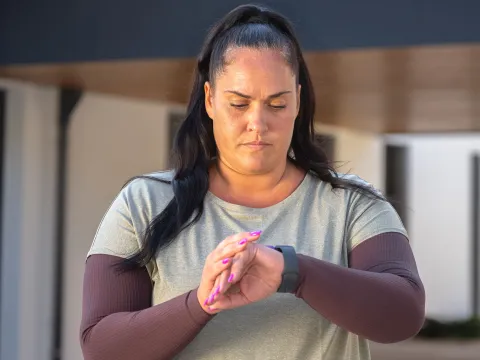- AdventHealth

Choose the health content that’s right for you, and get it delivered right in your inbox.
For many men, an enlarged prostate is one common side effect of aging. For some, this change begins around age 40 and about half of the male population experience this condition by age 60.
Often, this change doesn’t lead to any significant issues. However, some men may experience sleep disruptions due to the need to use the bathroom frequently at night. You may also experience other urinary problems, including the inability to empty your bladder fully. In certain situations, this can lead to a condition known as benign prostatic hyperplasia (BPH) that requires aquablation therapy treatment.
Keep reading to learn from our expert urologist at AdventHealth Fish Memorial, Binod Sinha, MD, about how aquablation therapy works, learn if it’s right for you and learn more about HYDROS, the next generation of aquablation therapy.
What Is Aquablation Therapy?
“Removing obstructing tissue through surgery or laser procedures has traditionally been the most common form of treatment for persistent moderate to severe cases of benign prostatic hyperplasia, or BPH,” says Dr. Sinha. Though these procedures are helpful, the use of heat does bring risks, including erectile dysfunction.
One option to reduce certain risks is called aquablation therapy. This minimally invasive robotic approach uses heat-free technology to remove a precise amount of tissue using room-temperature water. No physical incision is required.
What Is BPH?
The prostate is a ping-pong ball-sized gland that makes a fluid that forms part of semen. The prostate surrounds the urethra, the tube that carries urine out of the bladder.
The technical term for an enlarged prostate is benign prostatic hyperplasia — “benign” because it’s not cancerous. However, BPH can cause problems. BPH with lower urinary tract symptoms (LUTS) is very common in men over 50. The likelihood of developing BPH increases with age — approximately 50% of men in their 50s, 60% in their 60s, 70% in their 70s and 80% in their 80s are affected. Treatment for BPH and LUTS focuses on improving quality of life. Options range from medications to minimally invasive surgical procedures.
According to the National Institute on Aging, other prostate problems include the following:
- Blood in urine or semen
- Dribbling of urine
- Frequent pain or stiffness in the lower back, hips, pelvic or rectal area or upper thighs
- Frequent urge to urinate
- Need to urinate many times at night
- Painful ejaculation
- Pain or burning urination
“These symptoms could also be warning signs of prostate cancer, so getting them checked out is important,” says Dr. Sinha. Even if cancer is ruled out, you may still want to pursue symptom relief. That’s where aquablation therapy can help.
How Does Aquablation Work?
So, how does aquablation work? Its name provides a clue: It combines “aqua,” or water, with “ablation,” the surgical removal of tissue.
The process starts by mapping out the area needing treatment using detailed images from an ultrasound. “Aquablation therapy is the only procedure that gives a surgeon the ability to view the entire prostate during treatment,” says Dr. Sinha. “It allows the surgeon to map which parts of the prostate to remove and which parts to avoid, reducing the risk of irreversible complications like erectile dysfunction, ejaculatory dysfunction and incontinence.”
Using this personalized map, your surgeon programs a robotic system to guide a waterjet directly to only the intended tissue. “This treatment is tailor-made to fit the exact size of each prostate,” Dr. Sinha says. “With over five years of positive outcomes, it has become an increasingly popular option.”
“Every procedure is going to be different based on the size and position of the prostate,” says Dr. Sinha. Aquablation is an option for most men with enlarged prostates. However, it isn’t recommended for men with prostate cancer or certain other bladder conditions. Since aquablation treatment is relatively new, it includes a one-night hospital stay for observation.
Benefits of the HYDROS Robotic Aquablation System
AdventHealth Fish Memorial offers aqublation treatment with the leading-edge HYDROS Robotic System. This AI-powered platform designed for aquablation therapy is the only BPH treatment system that’s proven to deliver significant, lasting symptom relief while also preserving sexual function and continence in prostates of all sizes. This revolutionary system offers four advancements that set it apart from other aquablation therapy treatments. Let’s take a look at each.
AI-Powered Treatment Planning
This system offers AI-powered treatment planning through FirstAssist AI™. It has been built from various real-world aquablation therapy procedures and gives surgeons access to advanced imaging recognition software that identifies the affected area through ultrasound. Optimal treatment planning unique to each patient is made in real time based on the images collected.
Advanced Image Guidance
“This advanced technology gives us higher resolution video and a wider field of view during the procedure,” says Dr. Sinha. The system provides next-generation ultrasound imaging, digital cystoscopy and two high-definition touchscreens that allow the surgeon to optimize the procedure and deliver better outcomes.
Robotic Resection
HYDROS utilizes a heat-free, robotic-assisted waterjet that allows surgeons to remove obstructive tissue while protecting sensitive body parts by following the specific treatment plan. This greatly increases the efficiency and predictability of each procedure and standardizes the operation for patients with prostates of different shapes and sizes.
Streamlined Workflow
The HYDROS integrated tower improves the surgeon’s workflow by offering a more efficient setup in the operating room. The system's adjustable touchscreen monitors enhance surgeons' ergonomics and offer an intuitive software interface that simplifies the procedure by providing step-by-step guidance. “It’s completely changed the scope of aquablation therapy for patients and physicians,” says Dr. Sinha.
Helping You Return to Whole Health
Even though having an enlarged prostate isn’t life-threatening, whole-person health is our goal. Learn more about aquablation therapy and the HYDROS system, or reach out to schedule an appointment with Dr. Sinha here.




